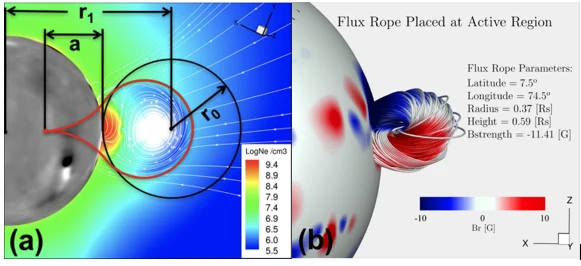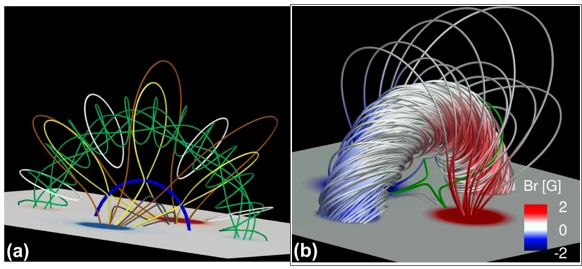EEG
About
EEG (Eruptive Event Generator) is a tool which uses observational data to calculate the parameters needed for simulating the generation and propagation of CMEs in the solar corona and inner heliosphere. EEG allows the user to specify the CME source region with the use of synoptic magnetogram data, which in turn provides the location and properties of the initial phase of CME. The corresponding parameters can be used in the AWSoM-R model to simulate the propagation of a CME in the solar corona and inner heliosphere.
Currently, EEG provides three ways to generate a CME, 1) Gibson-Low Fluxrope Model, 2) Titov–Démoulin Fluxrope Model, and 3) STatistical InjecTion of Condensed Helicity Model.
Gibson-Low (GL) Fluxrope Model
The GL model is a semi-empirical tool that initiates CMEs in global MHD simulations by inserting a Gibson–Low analytical flux rope into the coronal magnetic field based on observed active region magnetograms. The flux rope footpoint locations are selected by the user. GL determines the flux rope’s size, orientation, and magnetic strength to match observed CME speeds, enabling realistic simulation of CME initiation, propagation, and associated heliospheric impacts. Panel (a) in the figure below shows the configuration of the GL fluxrope, where the stretching parameter a determines the shape of the flux rope, r1 determines the initial position of the flux rope before it is stretched, r0 is the radius of the flux rope [1], and panel (b) shows an example fluxrope for a CME on 2013 April 11. The positional and physical parameters of the fluxropes are listed. More detailed information can be found in the reference below. This link shows one of the CME simulations using the Gibson-Low Fluxrope model and AWSoM-R.

Titov–Démoulin Fluxrope Model
The classic TD flux-rope model is extended to include finite-plasma-β conditions, providing closed-form analytical solutions for a twisted toroidal current of finite thickness embedded within a realistic coronal magnetic field. The equilibrium is split into two parts: an exact solution for the self-pinching of the filament and an approximate solution representing the external strapping field that balances the hoop force, which enables modeling of flux rope eruptions triggered by flux cancellation or reconnection by prescribing conditions that erode the strapping field, letting the configuration lose equilibrium and erupt. Importantly, this version predicts asymptotic CME speeds and ejected mass analytically—offering a direct way to tune simulation parameters to match observational data. Panels (a) and (b) show the magnetic configuration of a TD fluxrope [3]. (The user interface for TD is under development and will be available soon.)

STatistical InjecTion of Condensed Helicity (STITCH) Model
The STITCH model is an efficient, physics-inspired subgrid-scale approach designed to simulate the formation of a sheared arcade model for filament channels in the low solar corona rather than a twisted flux rope as in the GL and TD models. Instead of resolving all small-scale vortices, current sheets, and reconnection events that naturally form the filament channel, STITCH incorporates a simple yet powerful technique: it adds a single term to the MHD induction equation that directly injects tangential magnetic flux into the corona. This term emulates the net effect of helicity condensation—wherein small-scale turbulence reorganizes magnetic helicity into large-scale sheared structures localized around photospheric polarity inversion lines. The major advantages of STITCH for user-defined event simulation are that it is simple to implement: one need select only an active region and a single parameter, the rate of shear injection. Furthermore, it does not change the normal flux at the photosphere so that is preserved throughout the simulation. As a result of this latter property, STITCH can be used as a trigger for flux rope eruptions, and is presently implemented in EEG as one of the methods for triggering TD flux rope eruptions.
The figures below illustrate the STITCH process for the active region associated with the March 15, 2015 CME event [5], covering a total duration of one hour. Using STITCH is particularly convenient for active regions with complicated polarity inversion lines, as it efficiently handles their complex magnetic structures.

Disclaimer
EEG is still being improved with revised model parameters so results may vary. Please contact us if results do not match expectations as we strive to improve the model. Contact info of developers is below.
Developers of EEG
GL
TD
STITCH
CCMC Interface
References
- Sachdeva et al, in preparation
Publication Policy
For tracking purposes for our government sponsors, we ask that you notify the CCMC whenever you use any CCMC tools/software systems in any scientific publications and/or presentations. Follow the steps on the publication submission page
See our full publication policy for a sample 'acknowledgement statement' to be included in your publication.